
A gin and tonic is a highball cocktail made with gin and tonic water poured over a large amount of ice. The ratio of gin to tonic varies according to taste, strength of the gin, other drink mixers being added, etc., with most recipes calling for a ratio between 1:1 and 1:3. It is usually garnished with a slice or wedge of lime. To preserve effervescence, the tonic can be poured down a bar spoon. The ice cools the gin, dulling the effect of the alcohol in the mouth and making the drink more pleasant and refreshing to taste.

Vermouth is an aromatized fortified wine, flavoured with various botanicals and sometimes colored. The modern versions of the beverage were first produced in the mid- to late 18th century in Turin, Italy. While vermouth was traditionally used for medicinal purposes, it was later served as an apéritif, with fashionable cafés in Turin serving it to guests around the clock. In the late 19th century, it became popular with bartenders as a key ingredient for cocktails, such as the martini, the Manhattan, the Rob Roy, and the Negroni. In addition to being consumed as an apéritif or cocktail ingredient, vermouth is sometimes used as an alternative to white wine in cooking.

Mulled wine, also known as spiced wine, is an alcoholic drink usually made with red wine, along with various mulling spices and sometimes raisins, served hot or warm. It is a traditional drink during winter, especially around Christmas. It is served at Christmas markets in Europe. There are non-alcoholic versions of it. Vodka-spiked mulled wine can be found in Polish Christmas markets, where mulled wine is commonly used as a mixer.

Akvavit or aquavit is a distilled spirit that is principally produced in Scandinavia, where it has been produced since the 15th century. Akvavit is distilled from grain or potatoes, and is flavoured with a variety of herbs. It is also popular in Northern Germany.

Bitters is traditionally an alcoholic preparation flavored with botanical matter for a bitter or bittersweet flavor. Originally, numerous longstanding brands of bitters were developed as patent medicines, but now are sold as digestifs, sometimes with herbal properties, and as cocktail flavorings.

Danish cuisine originated from the peasant population's own local produce and was enhanced by cooking techniques developed in the late 19th century and the wider availability of goods during and after the Industrial Revolution. Open sandwiches, known as smørrebrød, which in their basic form are the usual fare for lunch, can be considered a national speciality when prepared and decorated with a variety of fine ingredients. Hot meals are typically prepared with meat or fish. Substantial meat and fish dishes includes flæskesteg and kogt torsk with mustard sauce and trimmings. Ground meats became widespread during the industrial revolution and traditional dishes that are still popular include frikadeller, karbonader and medisterpølse. Denmark is known for its Carlsberg and Tuborg beers and for its akvavit and bitters, but amongst the Danes themselves imported wine has gained steadily in popularity since the 1960s.

Pernod Ricard is a French company best known for its anise-flavoured pastis apéritifs Pernod Anise and Ricard Pastis. The world’s second-largest wine and spirits seller, it also produces several other types of pastis.

Snaps is a Danish and Swedish word for a small shot of a strong alcoholic beverage taken during the course of a meal. A ritual that is associated with drinking snaps is a tradition in Scandinavia, especially in Denmark and Sweden, where it is very common to drink snaps at holidays such as Midsummer, Christmas and Easter. This ritual has been described by one author as follows:
A group of people are clustered around a table for a typical lunch that will include several courses and a clear, fiery drink. The host pours the ice-cold liquid into frosty, conical glasses with long stems. He raises his glass, at which point the diners turn to one another and make eye contact, making certain not to leave anyone out. "Skål!" calls out the host, and everyone takes a sip. Again there is eye contact, and then the glasses are set on the table, not to be lifted again until the host raises his. The liquid is aquavit. The ritual is virtually the same throughout Scandinavia.
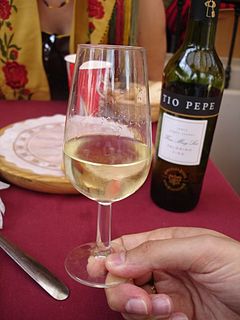
Apéritifs and digestifs are drinks, typically alcoholic, that are normally served before (apéritif) or after (digestif) a meal.
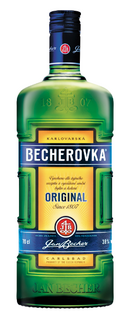
Becherovka, formerly Karlsbader Becherbitter, is a herbal bitters, often drunk as a digestif. It is produced in Karlovy Vary, Czech Republic by the Jan Becher company. The brand is owned by Pernod Ricard. It is made from a secret recipe based on more than twenty types of herbs and spices.
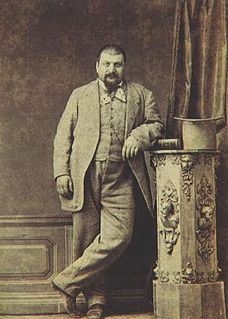
Gaspare Campari (1828–1882) was an Italian drinks manufacturer.
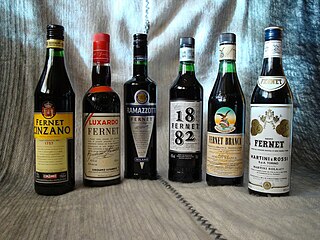
Fernet is an Italian type of amaro, a bitter, aromatic spirit. Fernet is made from a number of herbs and spices which vary according to the brand, but usually include myrrh, rhubarb, chamomile, cardamom, aloe, and especially saffron, with a base of distilled grape spirits.

Amaro is an Italian herbal liqueur that is commonly consumed as an after-dinner digestif. It usually has a bitter-sweet flavour, sometimes syrupy, and has an alcohol content between 16% and 40%.

A Spritz Veneziano is an Italian wine-based cocktail, commonly served as an aperitif in Northeast Italy. It consists of prosecco, digestive bitters and soda water.

Arcus AS is Norway's largest wholesaler of wine and liquor. It was created when it was demerged from the state-owned wine and liquor retailer Vinmonopolet on January 1, 1996. The retailing operations were kept in Vinmonopolet; import, export, production, and storage were transferred to Arcus.

Schierker Feuerstein is a German herbal liqueur, a half-bitters at a strength of 35% alcohol by volume, originally produced in the village of Schierke, located in the Upper Harz region of Saxony-Anhalt, Germany. Due to its red-brown coloration, the liqueur is named after the so-called Feuersteinklippe, a rock formation near the village made of reddish granite.

Danish Distillers is a company that was headquartered in Aalborg, Denmark. Isidor Henius, the father of Max Henius, was one of the founders of a company that was acquired by Danish Distillers, which ended up owning all Danish spirits production. It has been owned by the Norwegian-based Arcus Group since 2013. To avoid a dominant position in the Danish market, Arcus had to divest the brand Brøndums Snaps (akvavit). This brand was sold to Finland's Altia group spirits producer. The brands were not reunited in 2021 when Arcus and Altia merged to form Anora Group as Altia sold Brøndums to Galatea ahead of the merger.
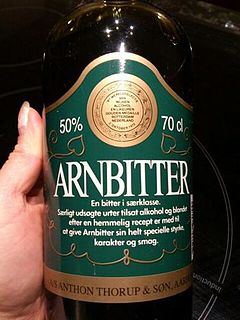
Arnbitter is a Danish bitters produced and distributed by the Copenhagen based company Just Drinks, originally produced and developed in Aarhus. The drink can be traced back to the 1950s and is sold under the slogan "Hverken ny, trendy eller importeret". The recipe is secret but includes ginger, cloves, saffron and licorice root. Arnbitter is mixed in large 2,500 litre copper tanks where it is stored for 3 months before bottling.
Anora Group Plc is a Nordic distilled beverage and wine company. It was formed in 2021 as a result of the merger of Norway's Arcus Group and Finland's Altia Group. Headquartered in Helsinki, Finland, Anora has offices in each of the Nordic capital cities. Anora’s four business areas are: wine, spirits, international and Anora Industrial.


















